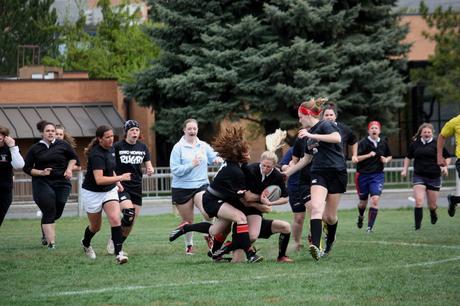
Rugby festival
Like any other sport, there are several “official” competitions sanctioned by licensed organizations for college rugby. But there are also unofficial matches — our “friendlies,” our festivals. During these events, teams gather for weekends full of rugby matches, drinking, bruises, wearing over-the-top costumes, and even more rugby. Nothing says “fun” to these people quite like slamming into each other full force while a little buzzed and wearing a tutu.
I am one of those people.
I joined rugby a little late. In fact, I joined sports a little late. After a brief stint of cross country in middle school, I quit all athletic pursuits in favor of focusing on academics. But during my junior year of college, I needed to distract myself from a period of depression, and physical activity was a great way to pump endorphins through my system. I joined my school’s rugby team.
In some ways, going from playing no sports to playing a contact sport with no pads felt like going from zero to 60. But I quickly became enamoured with it. Rugby has a physical ferocity that I always found appealing. The sport celebrates endurance and strength. Thick thighs are revered as pillars of muscle. Hulking shoulders are envied for their lifting potential. Rugby doesn’t just value physical strength, either, but also aggression. Women are too often told to be submissive, but rugby requires equal effort from all players, no matter their gender. All rugby players are expected to lift their teammates multiple times a match and expected to run for 80 minutes. All players ache all over the next day.
But a muscular body type is not the only one celebrated in rugby. Petite girls also have a place on the team; their speed, juking, and the way they can fit through a defensive line is invaluable. Body positivity radiates from Rugby players. We’re confident and secure, because we don’t value how our bodies look as much as we do what they can do.
Beyond body image, women’s participation in rugby (or any sport) is physically healthy. Studies show that encouraging girls and women to be athletic leads to an increase in their overall health; Specifically, it lowers health issues that target women more than men, like rates of heart disease and obesity, and also benefits their mental health.
While women’s sports traditionally take a back seat to men’s in terms of fan engagement, rugby tends to be equally respected across gender lines. Especially on local or college teams, all players tend to be supportive of each other, regardless of their gender. It’s not uncommon to see men on the sidelines of a woman’s game at these festivals, discussing strategy with the same intensity that they would if they were watching their own teammates. The feeling of camaraderie extends past gender lines, in many ways, because both men and women are held to the same standards. And the community off the field is incredible, too — while we tackle each other repeatedly on the field and fix each other with our best intimidating stares, after the match we all come together, and there is nothing better than being told that you hit hard by the opposition before sharing a beer together.
But while playing rugby generally has revealed one of the best sides of myself, rugby festivals are not all fun and games. The events also reveal a contradictory aspect of rugby culture: a persistent undercurrent of traditional hypermasculinity. We don’t just “share a beer” with the opposing side, but seven or eight — in addition to shotski routines, drinking songs, beer pong, and so on. Few sober teammates stick around for these after-parties and the dynamics tend to devolve into those typical of most parties filled with college-aged men and women.
Sexual harassment and coercion happens in broad daylight during rugby festivals. I’ve seen it personally, and my teammates always caution others on the ride to these events. Men are known to have pressured impossibly drunk women to perform sexual favors for them in the middle of the beer garden where after-parties take place. Women are frequently denied entry to parties unless they flash the gatekeeper. And, perhaps most brazen of all, the major party at the end of the first day of these festivals includes a large cage made out of PVC pipe. Men pull drunk women in through the bars. The price to exit the cage is their demand to lick temporary tattoos onto their breasts or even more invasive, violating acts. And these things lead one to wonder: If these are the scenarios that happen with hundreds of eyes watching, what happens when no one is around?
I’m lucky enough not to personally have experienced these things. I’ve had great teammates, both men and women, who have kept me safe. But it’s easy to see how so many others weren’t as lucky. I want to stress that it sexual assault is no woman’s fault — no matter if she was drinking and no matter how much. Additionally, while I am mostly aware of incidents that have violated women, it also wouldn’t surprise me to hear that men have been sexually harassed at these events, either, and their experiences are no less important.
It’s hard to reconcile that these problems are part of the same community that has meant so much to me. I don’t understand how on one end of the pitch, women can be celebrating their teammate for giving everything she had into a game, while a barely-coherent women is being pressured to their knees at the other end. How can we be proud that our sport encourages women’s empowerment in one sense if we are still treated so poorly in another? How can we push for women’s empowerment not only the pitch, but in the beer garden? We need answers to these questions because one form of empowerment cannot come at the cost of the other.

